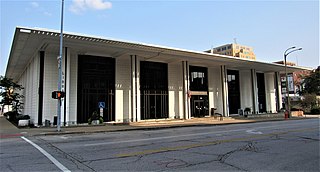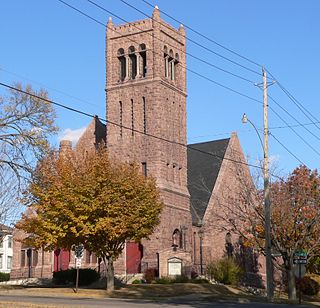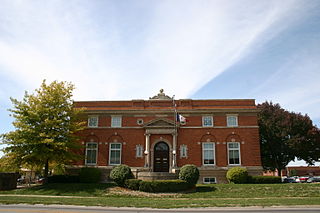
William LaBarthe Steele was an American architect from Chicago, Illinois. He is considered a principal member of the Prairie School Architectural Movement during the early 20th century.

The Huntington Beach Public Library (HBPL) is a library system located in Huntington Beach, California. It offers online databases, print and electronic books and magazines, children's programs, computer lab, DVDs, CDs, and audiobooks for anyone with a Huntington Beach Library card. Library cards are free to California residents. Free wireless access is available at all locations without a card.

Edward Lippincott Tilton was an American architect, with a practice in New York City, where he was born. He specialized in the design of libraries, completing about one hundred in the U.S. and Canada, including many Carnegie libraries and structures for educational institutions.

The Davenport Public Library is a public library located in Davenport, Iowa. With a history dating back to 1839, the Davenport Public Library's Main Library is currently housed in a 1960s building designed by Kennedy Center architect Edward Durell Stone. The Davenport Public Library system is made up of three libraries—the Main Library at 321 Main Street; the Fairmount Branch Library at 3000 N. Fairmount Street; and the Eastern Avenue Branch Library at 6000 Eastern Avenue.

St. Thomas Episcopal Church is a parish church in the Episcopal Diocese of Iowa. The church is located in Sioux City, Iowa, United States. The church building was listed on the National Register of Historic Places in 1984.

The Eldon Public Library is a public library and historic building located in Eldon, Iowa, United States. Established in 1906, the present building, completed in 1913 with a donation from Andrew Carnegie, is listed on the National Register of Historic Places.

The Cherokee Public Library is located in Cherokee, Iowa, United States. A library was begun in town in 1886 by the Cherokee Ladies Library Association. The collection of books was housed in the YMCA and other shared facilities. It was poorly funded, and the city of Cherokee took over the library in 1898 after voters passed a referendum. The Carnegie Corporation of New York had accepted the city's application for a grant for $10,000 on January 6, 1903. They hired Oskaloosa, Iowa architect Frank E. Wetherell to design the new building, which was built by Hansen and Lambkin of New Hampton, Iowa. Carnegie donated a further $2,000 to complete construction. It was dedicated on May 2, 1905.

The Carnegie Free Public Library, also known as the Carnegie Town Hall, is a historic Carnegie library located at 235 W. 10th St. in Sioux Falls, South Dakota. The library was built in 1903 through a $25,000 grant from the Carnegie Foundation. Architect Joseph Schwartz designed the building, a Romanesque Revival structure with Neoclassical influences. The library was built from locally quarried quartzite, a popular local building material at the turn of the century. While the building's massive form and rough-hewn stone exterior are Romanesque, it features a Greek pediment above the entrance supported by four pilasters on either side of the doorway. The building represents the only use of Classical details in a quartzite building in Sioux Falls.

The Clarinda Carnegie Library, now known as the Clarinda Carnegie Art Museum, is a historic building located in Clarinda, Iowa, United States. The Clarinda Public Library was organized in 1905. The library board applied for a grant from the Carnegie Corporation of New York for $15,000 on February 21, 1907. W.W. Welch was the architect of the Carnegie library building that was dedicated on April 15, 1909. In time the building became too small. The Lied Foundation of Las Vegas donated $1 million towards a new facility, and a special election held in October 2002 allowed the city to borrow the same amount for a new building. Groundbreaking for the new building took place on May 28, 2003, and the new Lied Public Library was opened on October 11, 2004. The old library building has been transformed into an art museum, and it was listed on the National Register of Historic Places in 2014.

The former Lake City Public Library is a historic structure located in Lake City, Iowa, United States. Efforts to establish a library began as early as 1889 when community socials were held to raise money for books. Women in the community, however, would not form a community library association until 1905. They sought donations of books and money from the community and were able to set up a subscription that year in the old primary building next to Central School. By 1908 there were 1,500 volumes in the library. The Association proposed to the city council in February of the same year that they turn their holdings over to the city for a free library. The council agreed to submit the proposal to the voters and the Association petitioned the Carnegie Corporation of New York for funds to build a new building. They accepted Lake City's application for a grant for $7,500 on May 8, 1908, and approved the library proposal in early June. S.T. and E.S. Hutchison donated the property. Denison, Iowa architect Edgar Lee Barber designed the Neoclassical building that was built by Nelson Construction Company. It opened in April 1910. There was no formal dedication. The building was listed on the National Register of Historic Places in 1990. The community has subsequently built a new library, and this building now houses a commercial business.

Oskaloosa Public Library is a facility located in Oskaloosa, Iowa, United States. Construction of the library was launched in 1902 with a grant from the Carnegie Corporation of New York. The building was added to the National Register of Historic Places in 1991.

Beuttler & Arnold was an architectural firm in Sioux City, Iowa that designed several works that are listed on the National Register of Historic Places for their architecture.

Chariton Public Library is located in Chariton, Iowa, United States. The Library and Reading Room Association was formed in Chariton in 1879, but it was short-lived. The county superintendent of schools started a teachers' library in the courthouse sometime afterward. By this time the community had a library of 800 volumes. There was an effort by study clubs in town in 1898 to raise money and establish a free public library. The Chariton Federation of Women's Clubs took the lead and opened a library with the books from the courthouse in two rooms above Gibbons Drug Store on the town square. Citizens approved a local tax to support the library the following year.

Onawa Public Library is located in Onawa, Iowa, United States. The public library began in 1902 when Judge Addison Oliver offered to buy the former Congregational Church for a library building, and funds to buy books and fixtures. His offer was accepted by the community, which also promised to maintain the facility as a free library. The library soon outgrew the old church and in November 1906 the board of directors approached the Carnegie Corporation of New York for a grant to build a library building. A $10,000 grant was approved on December 13, 1907. Judge Oliver donated another $10,000 for the building, and an additional $10,000 for an endowment fund. The Chicago architectural firm of Patton & Miller designed the Prairie School building, which was dedicated on October 22, 1909. It was listed on the National Register of Historic Places in 1979.

Woodbine Public Library, also known as Carnegie Public Library, is located in Woodbine, Iowa, United States. The library was organized in 1907, and it was initially housed in the jail section of city hall. If there was inmate in the jail the public had no access to the library. The city council appointed a board of trustees in 1908 and they applied to the Andrew Carnegie for a grant to build a library building. They received a grant on April 28, 1909, for $7,500. Eisentraut and Company, a Sioux City architectural firm designed the Prairie School building. F.X. White of Eldora, Iowa was the contractor. The building was completed in February 1909, and it was dedicated on March 9 of the same year. This was the first library built in Harrison County.

The Mason City Public Library is located in Mason City, Iowa, United States. The building that was funded by Andrew Carnegie, and is now an office building, was listed on the National Register of Historic Places in 1989. It was included as a contributing property in the Mason City Downtown Historic District in 2005.

The Davidson Building is a historic building located in Sioux City, Iowa, United States. It was constructed by local businessmen and real estate developers Ben and Dave Davidson. They saw the need for an upscale office building for professionals. They hired prominent local architect William L. Steele to design the Early Commercial-style structure. It was built by the leading contractor in the city, Lytle Construction Company. Completed in 1913, it was Sioux City's first office building. The exterior of the L-shaped, six-story building is composed of terra cotta panels separated by vertical bands of Roman style brick, and capped with an ornate cornice. It is Sullivanesque in its design. Commercial space is located on the first floor, and office space occupies the upper floors. The building was listed on the National Register of Historic Places in 1999. In 2016 plans were unveiled to convert the building and the adjacent Warrior Hotel into a boutique hotel and apartments. The Davidson Building houses The Warrior Apartments, as well as 56 guest rooms for The Warrior Hotel on its second, third and fourth floors.

The Sioux City Public Library-North Side Branch, also known as Bruce Meyer Productions, is a historic building located in Sioux City, Iowa, United States. The city received a total of $85,000 in 1911 from Andrew Carnegie to build the main library and the Leeds branch library. It was the only city in Iowa to receive a grant for both a main and branch library. A $100,000 bond issue passed in 1926 to replace the temporary facilities for the other branch libraries throughout the city. The North Side Branch was designed by local architect William L. Steele in the Tudor Revival style, and was completed in 1929. It was used as a branch facility until 1982 when the city closed all of the branch libraries in 1982, except the Morningside branch. A new branch library was created on the north side. The old north branch was sold to Bruce Meyer for his photography studio. It was listed on the National Register of Historic Places in 2000.

The Carnegie-Stout Public Library is located in Dubuque, Iowa, United States. The public library had its beginnings with the Young Men's Literary Association, established in 1859, and their book collection was the basis for the library's collection. The books were housed in a variety of buildings over the years. The community applied for a grant from Andrew Carnegie who on January 12, 1901, contributed $71,500 to build the library building. Local businessman Frank D. Stout donated the property, which was worth $20,000, in honor of his father Henry L. Stout. The two-story Bedford stone and brick building was designed by Chicago architects W. G. Williamson and John Spencer. It is considered one of the finest examples of the Classical tradition of Beaux-Arts architecture in Iowa. The main facade is dominated by a Roman Corinthian portico that was modeled after the Pantheon in Rome. Its fluted columns are matched with pilasters on the wall behind. The building was dedicated on October 17, 1902, and it opened three days later. It was individually listed on the National Register of Historic Places in 1975, and it was included as a contributing property in the Jackson Park Historic District in 1986. An addition was added to the east side of the building in 1981.

The Indianola Carnegie Library is a historic building located in Indianola, Iowa, United States. In November 1902 the local library board submitted a grant application to Andrew Carnegie so they could build a new building. The $10,000 grant was approved on January 13, 1903, and $2,000 was added at a later date. The Indianola City Council agreed to allocate $1,000 a year toward its upkeep. They also bought two lots at the corner of Buxton and Boston. One of the lots was owned by the family of Hannah Babb, the city librarian. Local architect Frederick W. Keith designed the brick Neoclassical structure, and it was built by G.W. James. The library eventually outgrew the building and it was replaced in 1984. The Des Moines Metro Opera has their offices in the old Carnegie building. It was listed on the National Register of Historic Places in 2017.























